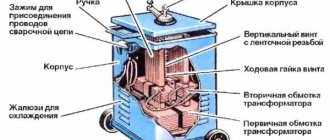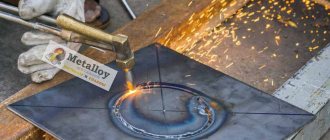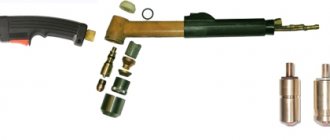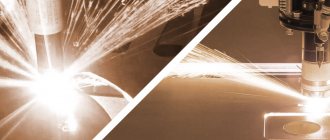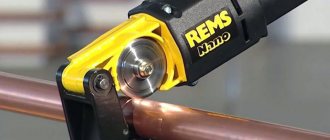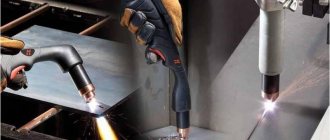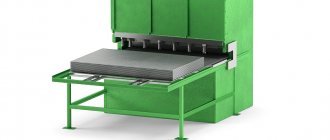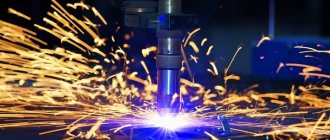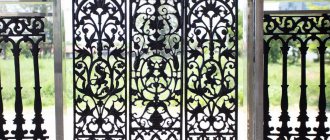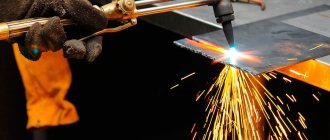Home / Library / News / Plasma cutting of aluminum: myths and reality
The plasma cutting process has been developed for a long time, but it is constantly being improved. In any discussion about how to cut metal, the conversation immediately turns to laser and waterjet cutting. However, when cutting aluminum, things are not so obvious.
Plasma cutting has been around for decades. The first plasma cutting machines were “raw” in terms of control and drive systems, as was the technology itself.
Plasma cutting system manufacturers have made many improvements in recent years, but many end users are still using older machines or purchasing units that are not up to date. As a result, some ideas about plasma cutting have become outdated.
There are huge differences between old and modern systems. Those professionals who are familiar with older models may not be interested in modern plasma cutting technology because their expectations in this area are much lower. There really is a problem with technical staff awareness.
The following are misconceptions that many users have about aluminum plasma cutting.
Misconception No. 3: Plasma leaves difficult-to-clean contaminants on the aluminum surface.
When plasma cutting is set up correctly, there should be no or no more contamination on the surface than with any other process. There are different types of aluminum, but for the most part, users should not encounter any major problems with the surface of the aluminum.
Like porosity at the cutting edge, the surface condition also depends on the choice of gas. If you cut it with air you will end up with a lot of rough aluminum oxide and a rough edge to the surface. If you cut it with inert gases, then with the correct selection of gas you can get a beautiful, smooth surface.
Photos of parts cut on CNC plasma
Aluminum is a material that is actively used in various sectors of human activity. Various technologies and techniques are used to cut it, but plasma cutting is the most effective. It makes it possible to quickly obtain a workpiece of the required size and with a profile of varying complexity. The quality of the cut is at the highest level and does not cause the least complaints.
Misconception #4: Laser cutting of aluminum is more cost effective than plasma cutting.
Lasers achieve their speed from an exothermic reaction when they are used to cut mild steel. The exothermic reaction uses oxygen as an auxiliary gas, which leads to problems when working with aluminum. Oxygen cannot be used to laser cut aluminum; high pressure nitrogen is required instead.
You don't benefit from the extra heat generated by the reaction with oxygen, causing cutting speed to be greatly reduced and the amount of nitrogen consumed becomes enormous to the point where cutting operating costs increase significantly. When plasma cutting aluminum, the opposite is true, and this provides huge cost advantages over lasers.
Laser cutting also requires a much higher investment in equipment. Production workshops must purchase both the laser equipment itself and protective casings for it. Unless the application requires very high edge quality or very high precision, then plasma is probably the most cost-effective process. Lasers are also more limited in thickness than plasma: about 20mm maximum for lasers and 150mm for plasma.
In some conditions, laser cutting has economic benefits, especially on thin sheet metal or in very large productions. But when a shop is cutting sheets thicker than 5mm, plasma cutting makes the most sense from an operating cost point of view. Additionally, businesses typically calculate their operating expenses in terms of cost per hour, but it makes more sense to calculate them in terms of cost per meter.
If you take into account only the cost per hour of work, then productivity is not taken into account. Costs are calculated not by time, but by consumable items, which is why cost per meter is a much better way to compare operating costs.
Plasma cutting of aluminum
If you need to cut aluminum with plasma, the first two questions you might ask yourself are: is plasma the right technology for cutting this metal and, if so, how best to use it to quickly get a clean, high-quality cut.
It has long been known that plasma is an excellent solution for cutting steel, but the properties of aluminum have many differences, among which the important one is the melting point. So, is plasma cutting steel the right choice when working with aluminum?
Yes! The plasma process is a fast, affordable and easy way to perform cutting. Technology has advanced tremendously over the past two decades, so using the right equipment and gas mixtures, as well as understanding the process and requirements required to cut aluminum, can produce excellent results today.
Like other metals, aluminum has its own unique characteristics that determine what steps must be taken and what steps must be avoided for plasma cutting to be effective.
In this article, we will provide precise explanations of why plasma is great for cutting aluminum. We'll do this by answering eight of the most frequently asked questions on this topic, which we hope will help you get the best results.
Can you cut aluminum with a plasma cutter?
Yes, as with other conductive metals, plasma cutting of aluminum is not only possible, it is very effective.
For the uninitiated, plasma cutting is a process in which a high-velocity jet of ionized gas is passed through an opening. The gas, after preheating and electrical ionization, forms a closed circuit through the torch and ground wire.
This ionized gas is called plasma. The more electrical energy is transferred to it, the hotter the plasma arc becomes. This arc is capable of melting metal, and the gas blows away the liquid material, thereby creating a cut in the right place. This process works great with aluminum as well.
But... I've heard that plasma cutting cannot maintain tight tolerances in the case of aluminum products and after it the metal surface needs to be cleaned, which is quite difficult to do.
Such statements occur due to misconceptions formed based on the results obtained from cars produced in the 1980s and early 90s.
Plasma cutting technology has undergone a major evolution.
These days, the improved process provided by both high-end and low-end systems has changed the situation dramatically.
Hypertherm's high-end XPR system offers a variety of cutting processes and combinations to ensure excellent results on a variety of aluminum thicknesses. Using this dual gas system gives manufacturers greater control and allows them to produce cleaner cuts at higher speeds.
In dual gas systems, the cutting gas is used in conjunction with a shielding gas. The shielding gas helps focus and direct the plasma and improves the quality of the cut and resulting surfaces.
Different combinations of cutting gas and shielding gas will produce different results. For example, the use of air plasma and air as a shielding gas is an economical combination that, at the current level of technology, provides a clean and fast cut.
The use of nitrogen plasma and water protection (if your machine has a water table, which is a prerequisite for such a combination) gives a very high-quality cut and helps to extend the service life of consumables.
Argon-hydrogen plasma and nitrogen as a shielding gas are an excellent solution when it comes to processing thick aluminum workpieces.
It's important to note that we're not just talking about expensive machines like the XPR systems. Cheaper solutions, such as Hypertherm's Powermax machines, which use air to generate plasma, can produce acceptable quality cuts across a range of aluminum thicknesses, including when working with thin sheet material. Which factor influences quality the most?
The single most important factor is your plasma cutter's ability to use the ideal gases at the ideal pressure level and cutting speed!
If the gases are chosen correctly, you can machine aluminum to achieve dross-free surfaces and excellent edges.
Cheap air plasma cutting systems are only designed to work with compressed air, which is why the quality of the edges is not as impeccable as when using industrial systems, which can use a special gas mixture such as argon-hydrogen.
XPR300 mechanized plasma cutting system
What cutting method is best for aluminum?
Plasma cutting of aluminum can provide significant advantages over laser processing, especially when it comes to thick material. The laser will cut through metal up to 25mm thick, while plasma can cut through 160mm thick aluminum sheet. Plasma is also more profitable financially, since the process requires lower equipment and operating costs.
Laser can provide the highest precision. It is undeniable that it allows you to cut out very small elements. However, the high precision that laser cutting provides can be critical for the aerospace industry or for projects that involve very small parts. The cutting quality provided by plasma is acceptable across a variety of industries in most applications.
| Index | Plasma cutting | Laser cutting |
| Accuracy | ✓ | |
| Range of thicknesses of cut material | ✓ | |
| Cost of equipment | ✓ | |
| Operating costs | ✓ | |
| Difficult to manage | ✓ |
Can your plasma cutter cut heavy gauge aluminum?
Regardless of your needs, knowing that plasma cutting aluminum can efficiently cut a variety of thicknesses adds confidence.
In earlier stages, plasma cutting systems were not able to guarantee consistently good results when varying thicknesses. For modern systems, it is not difficult to cut an aluminum sheet with a thickness of 38 mm (punched) or 50 mm from the edge.
Hypertherm's most advanced XPR systems use a patented VWI (Vapor Purged and Steam Shield) process that produces unsurpassed results when cutting a wide range of aluminum sheet thicknesses.
When processing sheets of greater thickness, choosing a gas mixture (the usual composition is argon, hydrogen, nitrogen) with a higher current strength and high cutting speed will allow you to obtain a very smooth surface, speeding up and simplifying the process.
If there is a need to process aluminum sheets of the greatest thickness, then the Hypertherm HPR800XD machine is capable of punching at a thickness of 75 mm and cutting from the edge of a sheet up to 160 mm thick!
This incredible advance in plasma processing technology makes it possible to look back on the poor results that have previously occurred with the process as a thing of the past.
What gas is suitable for cutting aluminum?
If we consider an air-plasma system, then determining preferences is not difficult - you will use clean, dry air for cutting (which, of course, consists of 78% nitrogen) as a plasma-forming agent. This will allow you to cut products of quite acceptable quality, working with a wide range of thicknesses. Air is the most economical gas, but the surface after cutting with it is rough and coated with aluminum oxide. Intermediate (eg MaxPro200) or industrial (eg XPR300) plasma cutting systems are preferred by many manufacturers because they provide better results when cutting aluminum. The use of more exotic gas mixtures often results in high quality cut surfaces. Dual-gas systems are also better suited for cutting weld-ready parts without additional processing, since the process does not use oxygen. Industrial systems (eg XPR300) are best suited for aluminum parts as they produce high-quality, dross-free cutting surfaces across a wide range of thicknesses.
Below we briefly describe the features of various plasma-forming gases that appear when processing aluminum products with plasma cutting machines.
| Plasma gas/shielding gas | ✓ For | ✗ Against |
| Air/Air | Cheaper, good cutting quality and speed | Rougher cutting surface, greater deviation from perpendicularity |
| N2/air | Cheaper | Rougher cutting surface, greater deviation from perpendicularity |
| N2/N2 | Cheaper | Rougher cutting surface, greater deviation from perpendicularity |
| N2/CO2 | A little faster, better cut quality | Rougher cutting surface, greater deviation from perpendicularity |
| H35/N2 | Wider range of processed thicknesses, less deviation from perpendicularity of the cutting surface | Difficulties with gas supply, more expensive option |
| H35-N2/N2 | Wider range of processed thicknesses, less deviation from perpendicularity of the cutting surface | Difficulties with gas supply, can only be used with an Auto-gas console |
Quality of cuts in aluminum products treated with different plasma-forming gases
Recommendations:
It only makes sense to consider different plasma-forming gases if you have a dual-gas or multi-gas system.
If you are cutting thick sheet aluminum (more than 12 mm), you should give preference to argon and hydrogen.
If you are cutting thin sheet aluminum (less than 12mm), then for best results you should use nitrogen as the plasma gas in combination with CO2 used for protection. If necessary to reduce costs, use additional air. Its cost is less, and the cutting quality when using air is good.
If your system allows it, waterproofing will ensure the best edge quality and extend the life of your consumables.
Thickness range of processed material:
As noted above, using plasma, you can cut aluminum sheets up to 160 mm thick. The following table provides data on cutting thickness ranges for aluminum products using various gas and amperage combinations.
| Plasma gas/shielding gas | 45A | 130A | 200A | 260A | 400A | 600A | 800A |
| Air/Air | 1,2 — 6 | 6–25 | 10–20 | * | * | * | * |
| N2/air | * | * | * | 6–50 | 12–50 | * | * |
| N2/N2 | * | * | 8–20 | * | * | 40 — 80 | * |
| H35/N2 | * | 8–25 | 8–20 | 6–50 | 20 — 80 | 40–100 | 50–160 |
| H35-N2/N2 | * | 6–20 | 8–20 | 6–50 | 12 — 80 | * | * |
What hazards are created when cutting aluminum with plasma?
The use of plasma for cutting any metal requires compliance with safety requirements in order to prevent emergency situations associated with the use of electricity, prevent fires, protect the operator, control smoke and regulate noise. However, working with aluminum comes with some special risks. Please note that aluminum dust should not be mixed with dust generated when cutting mild steel (for example, in a filtration system) as this can lead to spontaneous heating. This phenomenon occurs infrequently, but a thermal reaction may occur in which aluminum dust reacts with iron oxides from the mild steel. This interaction is an exothermic chemical reaction. For this reason, careful handling of filter systems and monitoring of work sites is of paramount importance. Next on the list is the danger associated with using a water table. If an aluminum product is cut with a plasma machine on a water table, there is a risk of explosion due to the hydrogen released. This threat only exists when the product being processed is placed in a bath or chamber and submerged under water. When aluminum comes into contact with water, bubbles of hydrogen gas can be released, which, when collected under a submerged sheet on a cutting table, create a dangerous accumulation of hydrogen that can ignite from the plasma and cause equipment failure or injury to the operator. There is little risk when cutting small pieces as they are only submerged in water for a short period of time, but you need to be very careful when you are dealing with a large surface area that is submerged for an extended period of time. You can reduce the danger by using an aerator in your water table. Check with your table manufacturer before cutting aluminum to ensure that the water table, fume exhaust system, and other components of the plasma cutting system are designed to handle aluminum.
When should you not use plasma cutting when working with aluminum?
Aluminum sheet and plate can be cut successfully using plasma in most cases, however there are a few important exceptions.
The first exception applies to anodized aluminum. If aluminum has an anodic coating applied to increase the thickness of the natural oxide film on the surface, then this coating will be damaged near the cutting zone due to the high temperature at which the plasma processing process takes place.
The second exception is aluminum corrugated sheet for floors (also called “Diamant”, “Durbar” plate). Areas that protrude from the main surface of the sheet make it difficult to process on a plasma cutting machine because they affect the arc voltage adjustment of the torch height, which degrades the quality of the cuts or leads to intermittent contact with the torch tip.
The third exception is aluminum-lithium alloys. Never cut aluminum-lithium alloys in the presence of water.
Anodized Aluminum Sheet
Can plasma be used to cut aluminum on a water table?
You may have heard about the danger of a chemical reaction that can occur when plasma cutting a sheet placed on a water table.
The danger of explosion arising under such conditions is very real, since when cutting aluminum sheet in a water environment, hydrogen can accumulate under the sheet.
Heated aluminum is very prone to react with oxygen and is able to capture some of this gas from H2O molecules, releasing hydrogen atoms in the process. However, it should be noted that this hydrogen release is likely not harmful, especially if you are not cutting multiple sheets in a short period of time.
On the other hand, if you have to cut aluminum every day, you may want to install an air manifold at the bottom of the water table to create air bubbles in your water system so that hydrogen does not collect under the sheet.
What exactly is a bubble formation system? Can I make it myself?
You can make an aeration manifold using 50mm diameter PVC pipe with 25mm diameter elbows to connect the lines. In the distribution lines, holes with a diameter of 3 mm must be drilled at intervals of 150 mm.
Install plugs at the ends of the distribution lines to ensure that air flows evenly to all areas of the cutting area.
Then simply connect the manifold to your shop's compressed air supply and adjust the pressure regulator to ensure a continuous flow of bubbles.
So, is cutting aluminum with a water jet a safe process?
Yes. In general, plasma cutting of aluminum is safer than cutting stainless steel, which releases hexavalent chromium.
However, the table manufacturer should always be consulted to evaluate the hazards and take precautions to eliminate the risk of explosion by preventing the accumulation of hydrogen.
Manifold for purge or bubble formation when plasma cutting aluminum on a water table
What can be said about aluminum alloys?
Do not cut aluminum alloys underwater or on a water table unless you can prevent hydrogen buildup.
However, with proper precautions, most aluminum alloys can be cut on a water table.
WARNING: Never cut aluminum-lithium alloys in the presence of water, as this material may catch fire if it comes into contact with water.
How to choose the right cutting machine?
When choosing the equipment and processing methods that best suit your application, the first thing you need to do is prioritize your various needs. In some cases, productivity is the most important factor, while in other situations, the quality of the cut surface comes first.
If you need to meet extremely tight tolerances, you should consider using a fiber laser machine.
However, if you are looking for a cost-effective, high-performance solution, or need to cut aluminum thicker than 20mm, then a high-precision plasma cutting machine with an XPR plasma source may be just what you need. If cutting quality is not critical to you or you only occasionally cut aluminum, it is better to give preference to an air plasma system such as Powermax from Hypertherm.
Aluminum cut using a portable Powermax plasma cutter
Such systems provide a good balance between cut quality and availability. Air plasma systems are generally portable devices, but they can be mounted on a CNC plasma cutting machine table and operated in a more intensive mode.
Finally, choosing the best option for cutting aluminum is determined by the type of material you process every day. For this reason, we always recommend contacting the manufacturer of your plasma or laser cutting machine.
Whatever your aluminum processing needs, our team of experienced engineers can help you determine the right plasma cutting machine that best suits your needs.
When done correctly and using the appropriate equipment and settings, cutting aluminum with plasma is a simple process that produces excellent results.
Plasma cutting aluminum using the Hypertherm XPR300
Publication date:
23.02.2021
Share:
Final process setup
When determining which process to use to cut aluminum, professionals must determine the results that are most important to them. For some industries, productivity will be the most important criterion, while for others it will be edge cleanliness. Many plasma systems are capable of cutting using multiple processes, so they can be fine-tuned to meet your output requirements.
For example, a plasma system can cut 5mm thick aluminum at a variety of settings, ranging from 45A to 260A and gas/air or argon/helium gas combinations. Different currents and gases provide different results, such as increased productivity, good edge finishing or tight tolerances.
The facility can cut using 130A argon/helium if you need a good balance of productivity and quality, as well as a weld-ready edge. If high speed is important to the manufacturer and he plans to do subsequent processing, then he can work at maximum current as quickly as possible. Users themselves combine parameters, and their decision is usually dictated by the priority of the desired results.
To get the best solution to your metal cutting problem, you can always turn to specialists. They will select the optimal equipment and its operating modes to achieve maximum economic efficiency of production.
If you have any questions, the DeltaSvar team will provide any additional information you need, including information about our wide range of services. Just write an email or call us at +7 (343) 384-71-72 (extension 220).
Advantages and disadvantages of plasma metal cutting
Before talking about what advantages and disadvantages plasma cutting of metal has, it is necessary to decide what it will be compared with. The main competitors of this type of cutting are oxygen gas, laser and water jet methods of metal processing. Each of these technologies has its own specific application.
Plasma cutting of metals has a number of advantages and disadvantages.
The technology has the following advantages:
- the ability to cut metals of significant thickness, varying from 0.5 to 50 mm;
- high accuracy - from 0.25 to 0.35 mm;
- the ability to cut any types of metals (aluminum, copper, titanium, stainless steel, steel, etc.);
- speed when cutting thin metals, reaching 7 m/min, speed of penetration of processed materials;
- mobility of hand-held plasma devices;
- high degree of readiness of parts (the need for minimal cleaning of slag).
We recommend articles on metalworking
- Steel grades: classification and interpretation
- Aluminum grades and areas of their application
- Defects in metal products: causes and search methods
Among the disadvantages of plasma cutting of metals are:
- quite high cost of high-quality plasma devices;
- high cost of consumables (nozzles, electrodes, protective screens);
- minimum cutting taper.
What gases are used for plasma cutting of sheet metal
Let's take a closer look at the gases that are used in the process of plasma cutting of metals.
1. Air plasma cutting.
This technology involves the use of air to form plasma. This method can be called the cheapest. Using air, you can cut almost any metal - black and stainless steel, copper, brass, etc. Average quality and cutting speed allow it to be used by most users of this type of processing.
2. Plasma cutting using oxygen.
Professional plasma metal cutting machines, which provide higher quality and cutting speed, use oxygen. Quality in this case is expressed in the perpendicularity of the cut and the minimum amount of slag (burst) on the underside of the processed elements.
3. Plasma cutting of metal in a protective gas environment.
Modern professional installations require cutting in a protective gas environment. The cost of such equipment ranges from 5 to 12 million rubles. The cutting gases are oxygen (O2), nitrogen (N2), argon (Ar) and air. Certain proportions allow them to also be used as a protective medium. Thanks to the use of protective gases, the quality of plasma processing of thick metals (up to 50 mm thick) can be compared with laser processing.
Nuances of plasma cutting of various metals
Using plasma cutting, you can work with almost any type of metal, however, different materials require certain nuances that must be taken into account during the processing process. Let's take a closer look at the most commonly used metals.
1. Steel.
In this article we will not consider in detail the grades and compositions of steel, since the main criterion that is important for cutting is the carbon content in it. It is this that is the determining parameter that influences the quality of plasma cutting of metal.
- Low-carbon steel is best suited for plasma cutting; it is this steel that is taken into account by all manufacturers of plasma sources when creating cutting maps and determining tabulated values of current and cutting speed for steel of different thicknesses.
- High-carbon steel (including galvanized steel) can also be cut using plasma, but in this case, you can get a high-quality cut by fine-tuning the equipment and experimenting with cutting modes.
- In addition, it is possible to perform plasma cutting of alloy steels (including stainless steel). Since this type of steel is not often used in industrial production, manufacturers do not have tabular indicators for cutting it. However, it is worth noting that the difference in performance with cutting low-carbon steel differs in one direction or the other by no more than 20%.
For cutting high-alloy, thick-walled steel, a mixture of gases is more suitable. In this case, nitrogen, argon, and less often hydrogen are used, which makes it possible not to damage the metal structure in the processing zone.
2. Non-ferrous metals.
Cutting non-ferrous metals (aluminum, copper, titanium) is performed using the same mixture of gases, which includes nitrogen, argon and hydrogen. This choice is due to the high cost of the processed materials. Due to unstable cutting, workpieces may be damaged, which in turn will lead to significant financial losses. These metals can also be cut by air, but only when we are talking about small production volumes and average quality of the resulting edge.
